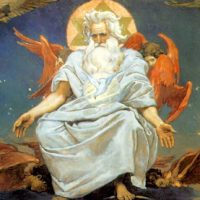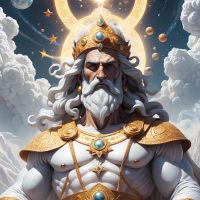Ghmerti : The Creator God
Listen
At a glance
| Description | |
|---|---|
| Origin | Georgian Mythology |
| Classification | Gods |
| Family Members | N/A |
| Region | Georgia |
| Associated With | Creation, Justice, Supreme Powers |
Ghmerti
Introduction
Ghmerti (ღვერთი) stands as the supreme deity in Georgian mythology, embodying creation, justice, and divine authority. Revered as the Lord of the Universe and the ultimate source of life, Ghmerti ruled over both gods and mortals long before Christianity reached the Caucasus. His name, derived from the Old Georgian “ɣmerti,” meaning “God,” continues to be the word used for the Christian God in the modern Georgian language. This linguistic continuity highlights how deeply Ghmerti’s image is woven into Georgia’s cultural and spiritual consciousness. In ancient polytheistic traditions, he was not merely a creator but also a guardian of cosmic balance, moral law, and human destiny.
Physical Traits
Descriptions of Ghmerti are rare and largely symbolic, as Georgian mythology traditionally refrains from depicting its supreme deity in human form. He is said to reside in the ninth sky, the highest and purest level of the cosmos, where he rules from a golden throne that radiates divine light. This imagery reflects his absolute authority over creation and his separation from earthly corruption. Ghmerti’s presence is often represented through natural phenomena such as sunlight piercing through clouds or thunder echoing through the mountains—symbols of his omnipotence and vigilance. When visualized, he is sometimes imagined as a luminous, elderly figure of great wisdom, clothed in celestial brightness rather than physical attributes.
Family
Ghmerti’s divine family illustrates the Georgian view of the cosmos as a balance of light, life, and moral order. He is regarded as the father of the Sun (his daughter) and the Moon (his son), celestial beings who illuminate the world under his guidance. Beyond his direct offspring, Ghmerti is associated with spiritual entities known as the Ghvtis Shvilni or “Children of God.” These divine agents serve as protectors of humanity, guiding mortals toward righteousness and shielding them from evil forces. According to early Georgian myths, Ghmerti’s creative act was opposed by a vengeful sister deity, representing the eternal struggle between good and evil. For every act of creation Ghmerti performed, she produced its dark counterpart, shaping the moral duality of the world. In later mythic developments, Ghmerti was also seen as part of a divine trinity called Sameuli, which includes Mze-Kali (the sun goddess of fertility) and Kviria (a divine mediator or prime minister of the gods).
Other names
Ghmerti is known by several titles that reflect his various divine roles and theological nuances. One of his most revered epithets is Morige Ghmerti, meaning “God the Director” or “God the Ruler,” emphasizing his command over all celestial and earthly realms. Another name, Dambadebeli, translates to “The Creator,” underscoring his role as the architect of the universe. In some regional traditions, he is called Zeskneli Ghmerti, or “God of the Upper World,” referring to his heavenly domain. These names evolved alongside Georgia’s religious transformation, blending pagan reverence with Christian theology. Over time, as Christianity spread, the term “Ghmerti” became synonymous with the Christian God, demonstrating how ancient faiths and newer doctrines merged into a single spiritual lexicon.
Powers and Abilities
As the supreme being, Ghmerti’s powers encompass every aspect of creation and existence. He is the divine architect who fashioned the universe from his own essence, establishing the three realms of heaven (Zeskneli), earth, and the underworld (Kveskneli). His dominion includes the elements of nature—controlling the weather, the fertility of the land, and the harmony of the cosmos. Ghmerti determines the fate of every living creature, setting the duration and events of human life with divine wisdom. He embodies perfect justice, rewarding good deeds and punishing wickedness, serving as the eternal moral compass for both gods and humans.
In mythic stories, Ghmerti is known to elevate mortals to divine status, transforming heroes into gods through their virtue and courage. He also grants divine weapons and wisdom to champions who defend the world from demonic beings like the Devi, the monstrous antagonists of Georgian lore. One such hero, Iakhsari, received his sacred bow and arrows directly from Ghmerti to fight these giants. In some folk traditions, Ghmerti is also linked to hunting and the forest, symbolizing humankind’s harmony with nature and the sacred responsibility to protect it. Unlike the impulsive or vengeful gods of neighboring mythologies, Ghmerti’s power is rooted in wisdom, justice, and the preservation of balance.
Modern Day Influence
The legacy of Ghmerti remains profoundly visible in Georgia’s spiritual and linguistic heritage. When Christianity became the state religion in the 4th century CE, the ancient reverence for Ghmerti was not abolished but transformed. The name “Ghmerti” was adopted into Christian theology to denote the one true God, effectively merging ancient pagan and Christian worldviews. This seamless transition illustrates how deeply ingrained Ghmerti was in Georgian identity—the concept of a supreme creator remained constant even as religious forms evolved.
In rural regions and mountain communities such as Svaneti and Khevsureti, elements of Ghmerti’s worship persist through folk rituals and oral traditions. Blessings, songs, and proverbs still invoke his name, blending Christian and pre-Christian spirituality. Festivals like Berikaoba and Keenoba, now celebrated in more secular or theatrical forms, continue to echo the mythic themes of creation, morality, and divine order first associated with Ghmerti.
In modern Georgia, the word “Ghmerti” continues to be used in religious prayers, blessings, and everyday speech, demonstrating its unbroken linguistic and cultural lineage. Georgian art and literature also preserve his image—sometimes as a symbol of divine justice, sometimes as a representation of the nation’s endurance and faith. Even contemporary writers reference Ghmerti as a bridge between the human and the divine, the ancient and the modern.
Through centuries of transformation—from pagan worship to Christian theology and modern nationalism—Ghmerti’s essence as the all-creating, all-knowing, and all-just deity has remained a cornerstone of Georgian identity. He continues to represent not just divine power, but the enduring belief in moral order, universal balance, and the sanctity of creation.
Related Images
Source
Encyclopædia Britannica. (n.d.). Georgian mythology. Retrieved from https://en.wikipedia.org/wiki/Georgian_mythology
Rustaveli Tripod. (n.d.). Georgian Mythology. Retrieved from https://rustaveli.tripod.com/mythology.html
Judgement Is Come. (2025, August 18). Georgian Religion – Imprimis Systems. Retrieved from https://www.judgementiscome.com/home/ethnic-religions/georgian-religion
Wikiwand. (2020, December 31). Georgian mythology. Retrieved from https://www.wikiwand.com/en/articles/Georgian_mythology
Georgia Travel. (n.d.). Pre-Christian Religions in Georgia: Exploring the Historical Background. Retrieved from https://georgia.to/en/pre-christian-religions-in-georgia/
Humanities Institute. (n.d.). The Caucasus Culture – Mythology. Retrieved from https://humanitiesinstitute.org/__static/e9614fbf2af30b9f4c04f87e65f2bcd1/caucasus-mythology(2).pdf?dl=1
Tuite, K. (1996). Highland Georgian paganism — archaism or innovation? University of Montreal. Retrieved from http://www.mapageweb.umontreal.ca/tuitekj/publications/tuite-1996-revkiknadze.pdf
Scribd. (2025, July 4). Georgian Folklore. Retrieved from https://www.scribd.com/document/251756871/Georgian-Folkore
Charachidze, G. (1986). Le système religieux de la Géorgie païenne. Paris: CNRS Éditions.
Bardavelidze, V. (1957). Ancient Religious Beliefs and Rituals of the Georgian People. Tbilisi: Metsniereba.
Eliade, M. (1964). Shamanism: Archaic Techniques of Ecstasy. Princeton University Press.
Rapp, S. H. (2003). Studies in Medieval Georgian Historiography: Early Texts and Eurasian Contexts. Peeters Publishers.
Frequently Asked Questions
What is lorem Ipsum?
I am text block. Click edit button to change this text. Lorem ipsum dolor sit amet, consectetur adipiscing elit. Ut elit tellus, luctus nec ullamcorper mattis, pulvinar dapibus leo.
What is lorem Ipsum?
I am text block. Click edit button to change this text. Lorem ipsum dolor sit amet, consectetur adipiscing elit. Ut elit tellus, luctus nec ullamcorper mattis, pulvinar dapibus leo.
What is lorem Ipsum?
I am text block. Click edit button to change this text. Lorem ipsum dolor sit amet, consectetur adipiscing elit. Ut elit tellus, luctus nec ullamcorper mattis, pulvinar dapibus leo.
What is lorem Ipsum?
I am text block. Click edit button to change this text. Lorem ipsum dolor sit amet, consectetur adipiscing elit. Ut elit tellus, luctus nec ullamcorper mattis, pulvinar dapibus leo.
What is lorem Ipsum?
I am text block. Click edit button to change this text. Lorem ipsum dolor sit amet, consectetur adipiscing elit. Ut elit tellus, luctus nec ullamcorper mattis, pulvinar dapibus leo.







